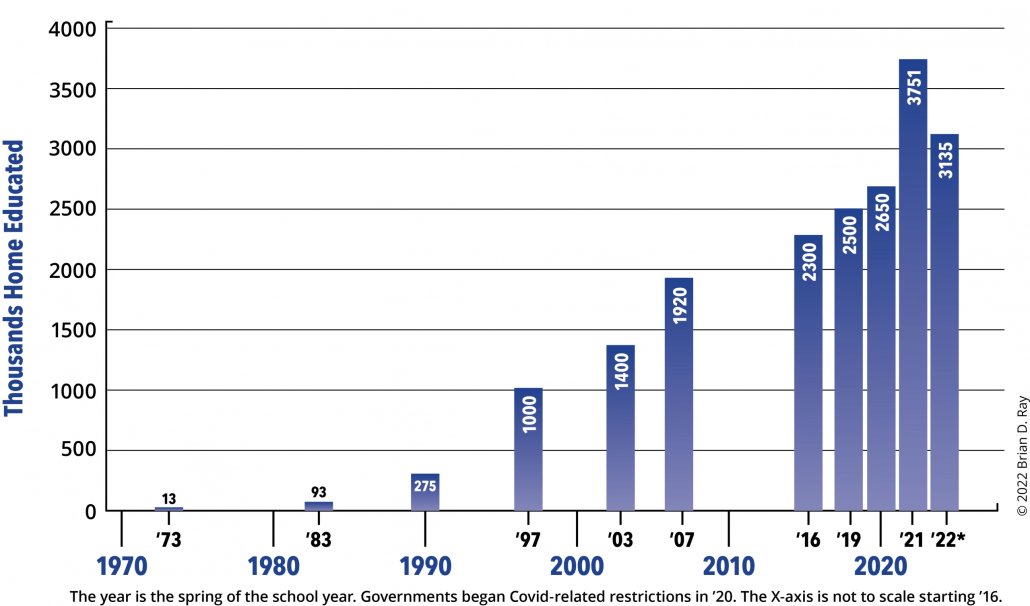
When the pandemic shut down the schools, many parents were horrified to see what their children were being taught on a daily basis. Others saw that “zoom school” just wasn’t a good way to educate children. As a result, many parents started homeschooling. Along with others, I read the news reports (like this one) covering this phenomenon.
Unfortunately, I have a rather cynical view of my fellow parents. I think that a lot of people who have children would be better off with pets, because they don’t really want to spend the time, effort, and energy necessary to properly raise their children. Thus, while I was happy to see more parents choosing the most effective model of education, I was skeptical that it would last.
Well, homeschooling researcher Dr. Brian Ray has released an analysis that at least partially confirms my cynical view. Using data from the United States Department of Education, the United States Census Bureau, an Education Next survey, and all state-level departments with relevant publicly available data, Dr. Ray estimated the number of students being homeschooled in 2020, 2021, and 2022 and then compared those numbers to previous estimates. The results are shown in the graph above.
Notice that homeschooling grew quite a bit from 2020 to 2021, which is consistent with the news reports. However, in 2022, the numbers dropped, which is consistent with my cynical view of my fellow parents. Nevertheless, I am actually surprised at how little the numbers dropped. Look at the growth in homeschooling from 2016 to 2019. In that three-year period, it grew by about 9%. Compare that to the growth from 2019 to 2022, which includes the year of decline. That growth is 25%! So even after a lot of people left homeschooling, the growth has still been unusually high.
Now, of course, there are at least two caveats here. First, it is very difficult to estimate the number of children being homeschooled. However, given the fact that Dr. Ray has been doing it for decades, I think he is probably the most reliable source on the matter. The second caveat is that 2022 might not be the last year in which the numbers drop. We will have to wait and see.
Nevertheless, given what we know now, it seems that many more parents have discovered the fact that homeschooling is the best solution for their children. More importantly, they have stuck with it (at least so far). This gives me more hope for the next generation.

Question, on the American biology teacher article. I know a carbon dating lab worker who insists the article ‘proves’ carbon 14 is contamination from modern sources. I see your response is that if that was true, there should be more carbon 14 on the outside rather then the inside of the bone. Is that right? Anything else you would say on the contamination issue?
Second they say if isn’t not containmination, that means that all fossil dinosaurs didn’t die at the right time during the flood. Either they all died at the same time or they died hundreds of years apart. How would you respond to this argument – that is the carbon 14 is correct, even if calibrated by moving it to thousands rather then tens of thousands, then somehow the dinosaurs died hundreds of years apart?
Thank you for your response.
The article doesn’t “prove” contamination. It asserts contamination without evidence. The fact that there isn’t more carbon-14 on the outside is not the only strong evidence against contamination. In this report it is found that when you order samples that are supposed to be millions of years old according to their amount of carbon-14, they naturally separate into four distinct groups. The plants were all in the group that had the lowest level of carbon-14, while the dinosaurs and megafauna formed three other groups. This kind of structure would not be expected in data that come from contamination.
You can’t take a fundamentally flawed dating system and “correct” it with some simple calibration. Yes, if you somehow try to compress the carbon-14 dates of dinosaur bones to a reasonable time scale, they don’t agree with one another, but that’s because the errors on the dates are so large to begin with. For example, when wood is found in rock that is supposed to be millions of years old, the carbon-14 system dates the wood as thousands of years old (see here and here for example). This isn’t because one date is right and the other is wrong. It’s because they are both wrong.